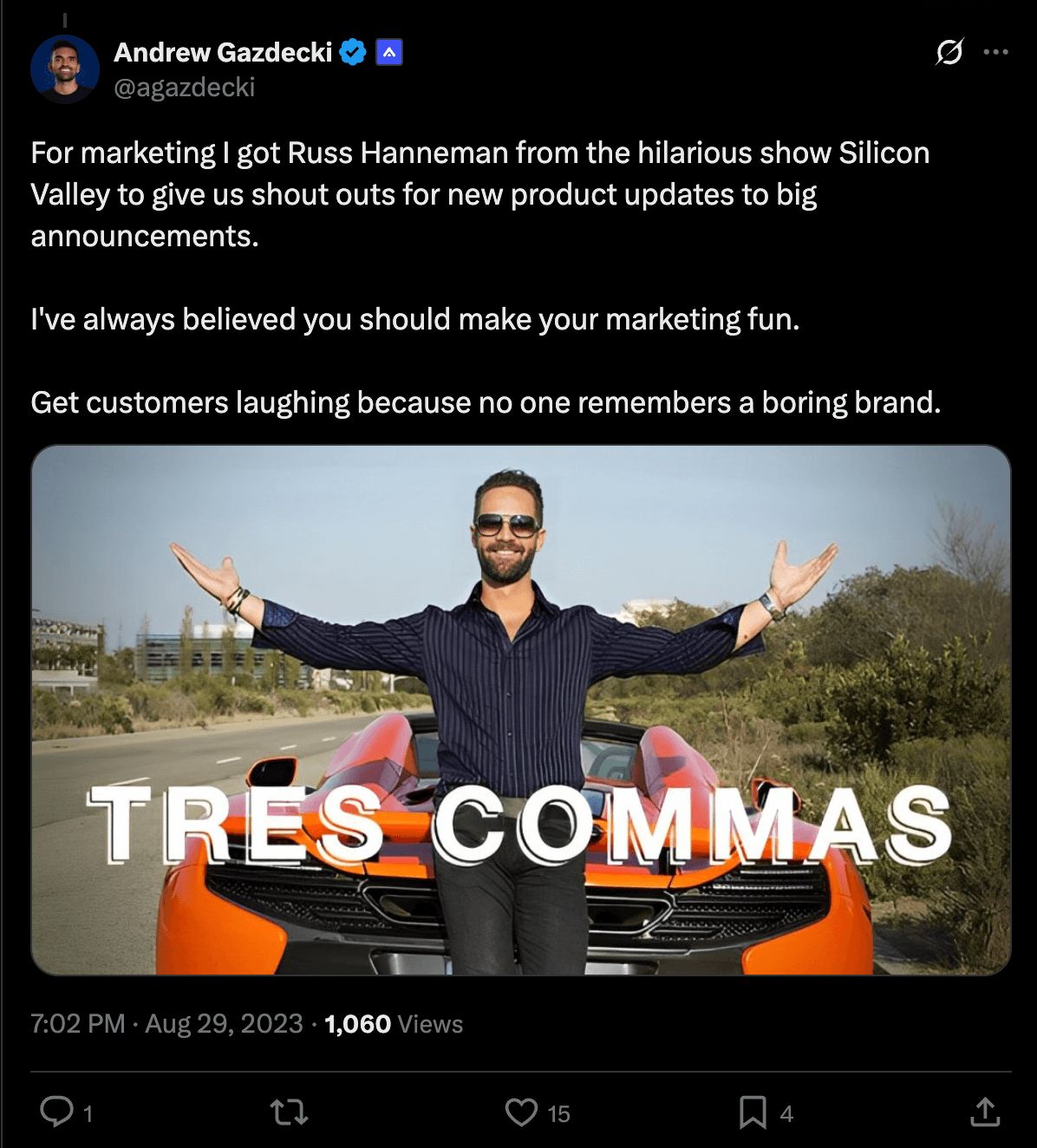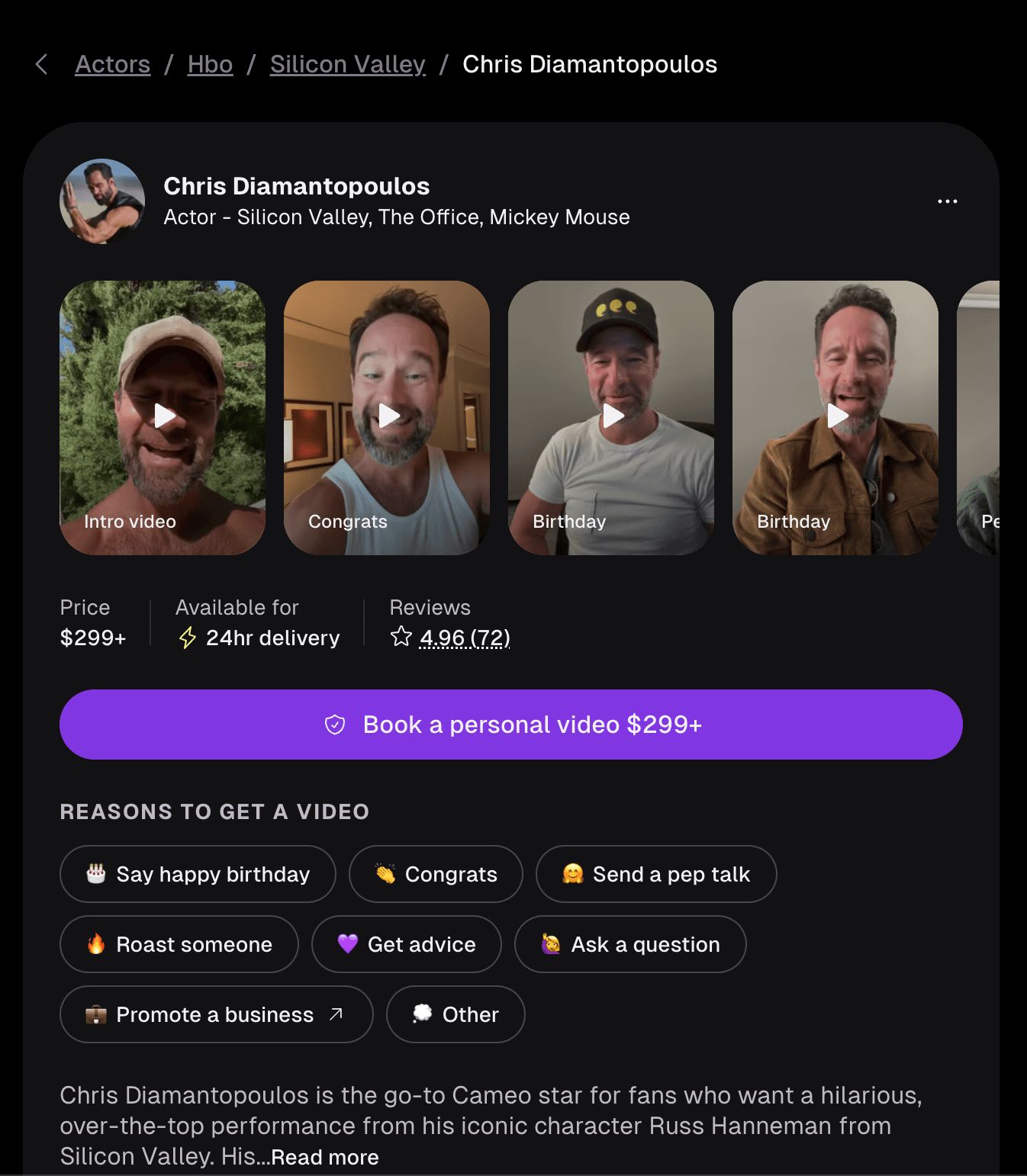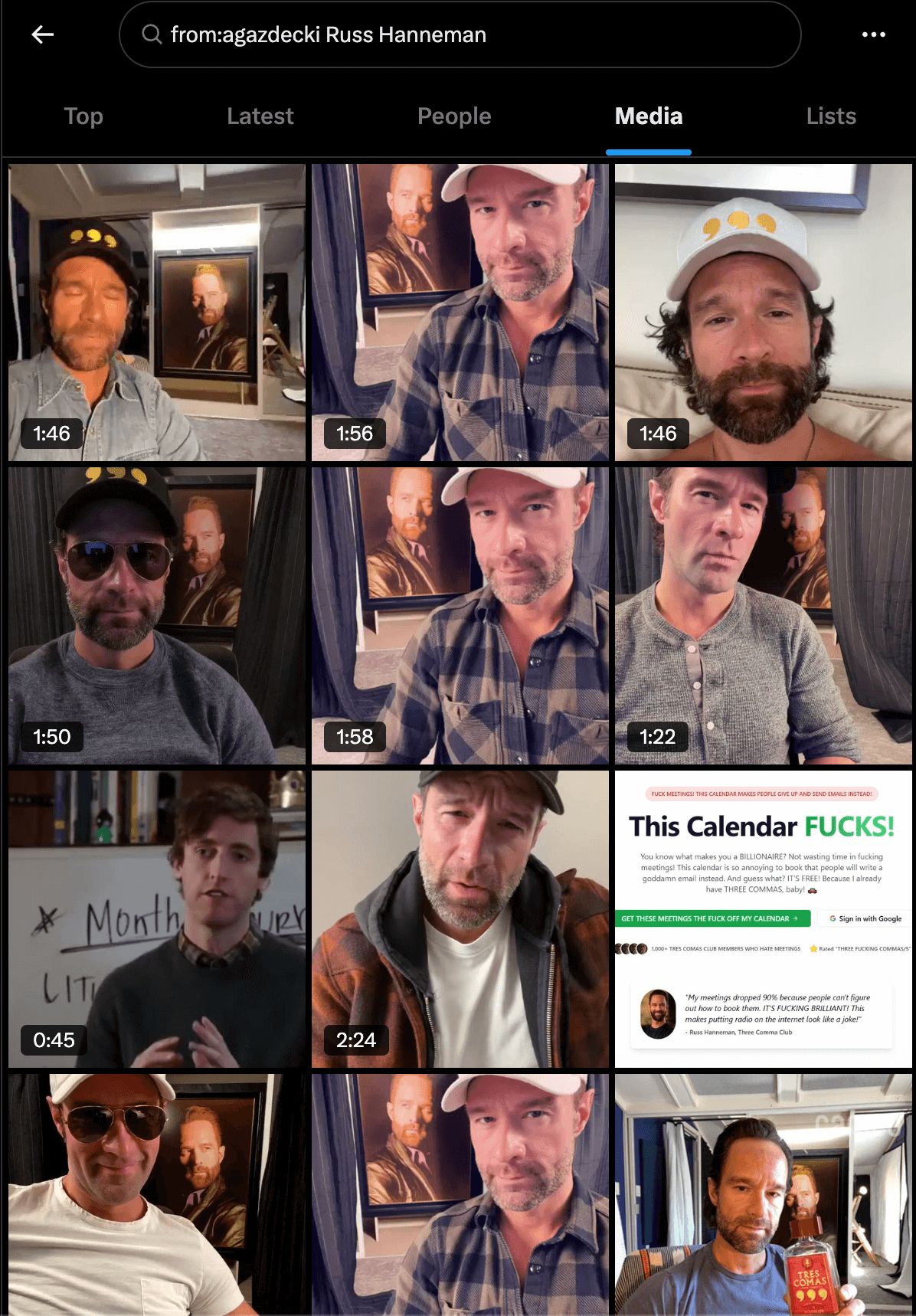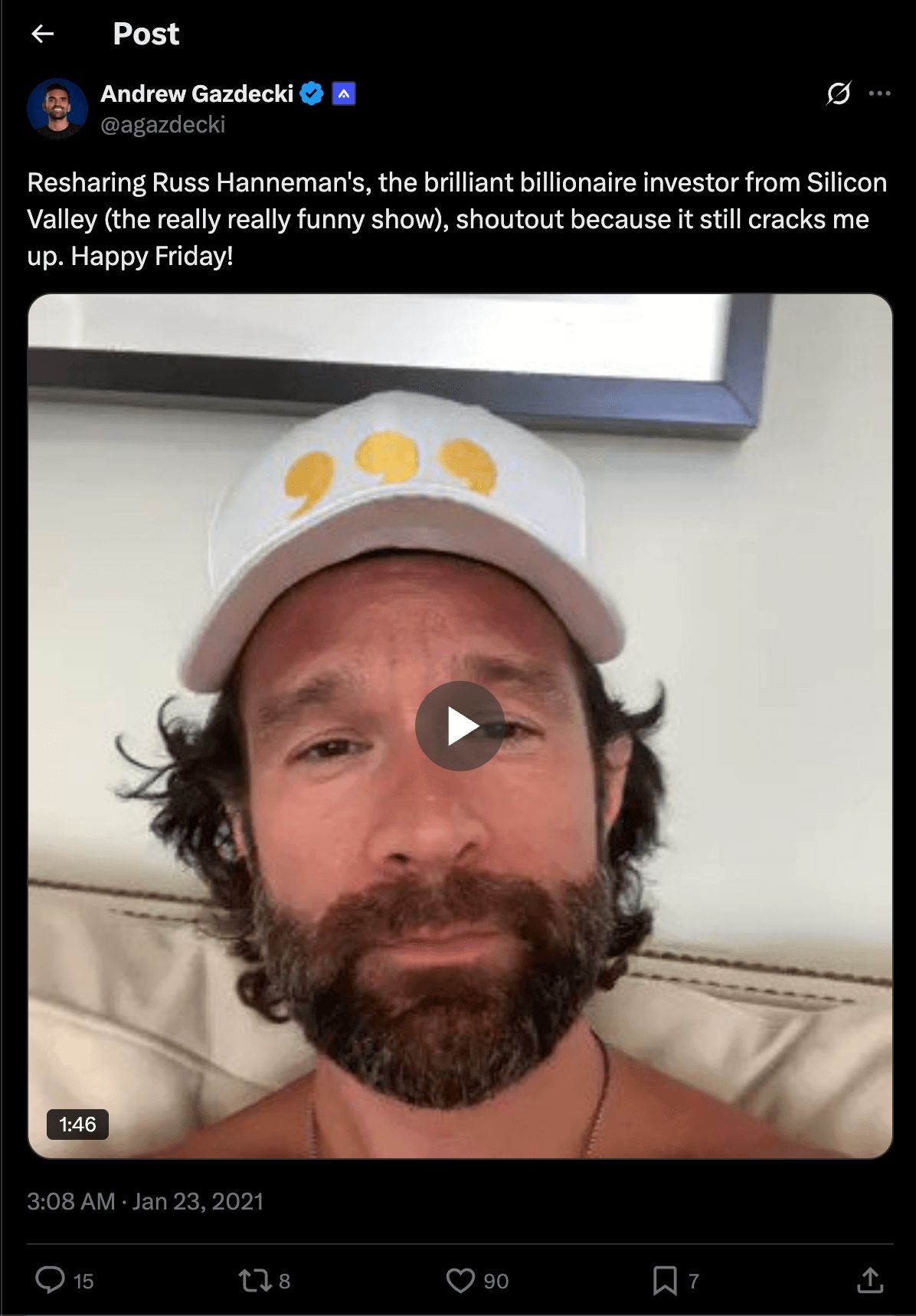- Startup Spells 🪄
- Posts
- Silicon Valley's Russ Hanneman: Acquire’s $299 Branding Hack (feat. Cameo)
Silicon Valley's Russ Hanneman: Acquire’s $299 Branding Hack (feat. Cameo)
PLUS: $380K Return On a $71k ad spend
Silicon Valley's Russ Hanneman: Acquire’s $299 Branding Hack (feat. Cameo)
Every great brand tells a story – and sometimes that story is co-authored by someone already famous.
When an emerging company pairs itself with a well-known personality or character, the familiarity and likability of that figure can rub off on the brand.
Instead of spending years building recognition from scratch, a startup can “borrow credibility” from an icon people already know and love.
This strategy isn’t about traditional celebrity endorsement contracts; it’s often about clever, authentic moments that get audiences laughing and paying attention.
Branding 101: A Game of Associations
What exactly is a “brand”? It’s more than a logo or slogan – it’s the sum of all associations people have with your company.
Entrepreneur Alex Hormozi offers a useful “Flower Bouquet” analogy: “Think of a brand as a bouquet of flowers” you assemble in people’s minds.
Each “flower” is an idea, emotion, or value associated with your company. For a new venture, many of those flowers are unknown buds – nobody recognizes them yet.
But if you tie your bouquet to blossoms people already recognize and love, your whole arrangement becomes more appealing. In other words, we link what people don’t know (your startup) with what they do know (a familiar personality or symbol)
Branding is essentially association: if customers see your product alongside something they admire, some of that admiration transfers to you.
Conversely, negative associations act like weeds in the garden – one bad element can ruin the bouquet.
Companies know this well. It’s the reason Apple famously forbids film villains from using iPhones on screen – they don’t want their brand associated with “bad guys.”
Apple meticulously controls how its products appear in media, ensuring they’re shown only “in the best light” and by favorable characters. Similarly, The Rock had it in his contracts that he cannot lose a fight in movies.
This highlights a core truth: a brand isn’t built in isolation; it’s shaped by context and comparison. By carefully choosing who and what you stand next to, you influence how people perceive you.
Why Your Brain Loves Famous Faces: The Psychology Behind Brand Association
Why does borrowing a familiar face or persona work so well in branding? It comes down to psychological phenomena like the mere exposure effect and the halo effect.
The mere exposure effect means people tend to prefer things they find familiar. We’re hard-wired to feel more comfortable and trusting toward something we’ve seen before. So, when a new company presents itself with a known figure, audiences are less likely to dismiss it – “Hey, I recognize that guy!” instantly lowers our guard.
Familiarity grabs attention in a noisy world. Studies have shown, for example, that consumers are far more likely to watch and recall an ad that features a celebrity they recognize. In marketing research, 60% of people said they’d watch an ad featuring their favorite celebrity – that recognition is powerful in cutting through ad fatigue.
The halo effect furthers this: we unconsciously transfer the qualities of the person to the product. If the spokesperson or character is funny, likable, or respectable, those qualities halo onto the brand. This builds instant credibility and personality for an otherwise unknown name. Over time, the attributes of the famous figure become associated with the brand itself.
Have you noticed how brands that partner with beloved celebrities often seem more “cool” or trustworthy like Ryan Reynolds' Mint Mobile? It’s no coincidence – the brand’s personality is being shaped in the consumer’s mind by the endorser’s image.
This can lead to very tangible benefits: increased sales and customer loyalty, as fans of the celebrity become fans of the product.
Another factor is social proof and authority. In the eyes of consumers, if someone influential or popular is involved with your brand, it signals that your brand is worth paying attention to.
It’s a form of third-party validation. Seeing an icon from pop culture they admire talking about a company piques curiosity as most people worship celebrities. In essence, the brand gets to “borrow” the trust and admiration that audience already has for that figure. This strategy, done well, can fast-track a startup from unfamiliar to familiar in the market.
Acquire’s Russ Hanneman Stunt: How Acquire Bet on a TV Character for Startup Announcements
One of the funniest (and most instructive) examples of borrowing credibility comes from MicroAcquire (now rebranded as Acquire.com), a startup marketplace for selling startups.
The founder, Andrew Gazdecki, had a hunch: everyone in his target audience of startup founders watches HBO’s Silicon Valley. So why not tap into that existing love?

Andrew Gazdecki x Russ Hanneman
He turned to Russ Hanneman, the over-the-top billionaire character from the show who famously loves “tres commas” (a nod to billionaires’ three-comma net worth). Russ Hanneman isn’t a real person – he’s played by actor Chris Diamantopoulos – but he’s a familiar face to tech entrepreneurs and carries a comedic, lovable swagger.

Russ Hanneman on Cameo
Gazdecki hired the actor via Cameo (a service that lets you buy personalized videos from celebrities) to record shout-out videos for Acquire.

Russ Hanneman - Cameos for Acquire
For a few hundred dollars, he got Russ Hanneman (in character) to jokingly hype up Acquire’s latest product updates and announcements.

Russ Hanneman - Announcements
The result was that the videos were a hit – they were hilarious, highly shareable, and instantly gave Acquire a jolt of cultural relevance.
Founders saw the posts and thought, “No way, Russ Hanneman is talking about this startup? That’s awesome.”
It made Acquire look more credible (after all, a famous investor from TV is endorsing them, even if tongue-in-cheek) and definitely more fun.
The cameo videos became a running gag and a trademark of Acquire’s launches. This comedic marketing move not only entertained their audience but also built brand familiarity at lightning speed.
Acquire, a relatively new company at the time, managed to associate itself with a beloved Silicon Valley character, effectively borrowing Russ’s popularity among tech folks and transferring some of that goodwill to themselves.
Why did it work so well?
First, Russ Hanneman was the perfect match for Acquire’s audience. He’s a tech investor character, so the context fit (it wouldn’t have been as effective if they’d hired a random Hollywood actor unrelated to startups).
Second, the approach was humorous and authentic – it didn’t feel like a forced advertisement, it felt like an inside joke shared with fellow founders. That authenticity matters; modern audiences (especially younger ones) can smell inauthentic marketing a mile away. By using a fictional character known for being outrageous, Acquire kept things light and memorable.
Lastly, Acquire’s use of Cameo highlights a practical tactic for startups: you don’t need a Super Bowl ad budget to get a celebrity involved.
Cameo and similar platforms have made influencer marketing on a budget possible. Around 3-4 years ago, business cameos that cost around $1,000 with a license for only few days didn't exist. So you could hire individual celebrities for cheaper.
The cost was low, and the return on attention was enormous.
It’s a hack that any scrappy marketer can consider: find a cult-favorite figure whose image aligns with your brand, and leverage their persona in your campaigns to immediately capture interest.
The Kim Kardashian Playbook of Borrowed Fame
If “brand by association” has a Hall of Fame, the Kardashians would surely be in it.
Love them or not, the Kardashian family provides a masterclass in leveraging associations to build a brand empire.
Kim Kardashian herself rose to fame in large part by associating with already-famous friends and then strategically partnering with high-profile figures. You might not see the Kardashians as business role models, but in terms of branding tactics, they illustrate the strategy of turning the unfamiliar into the familiar by standing next to the right people.
Kim Kardashian’s first brush with fame was being seen next to Paris Hilton, who was the reigning pop culture icon of the early 2000s.
In those days, Paris Hilton was ubiquitous – the paparazzi followed her every move, and tabloids couldn’t get enough. Kim started out as Paris’s stylist and friend, and by simply being “by association connected to Paris Hilton,” Kim began to get noticed.
Photographers who were already swarming Paris suddenly had Kim in the frame too.
For three years, one paparazzo recalls, “I photographed Kim Kardashian day and night” whenever she was with Paris, feeding the media machine so that Kim would appear in every tabloid alongside her famous friend.
In essence, Kim Kardashian piggybacked on Paris’s celebrity; the public saw her with Paris and started to recognize her as part of that glamorous scene.
The unfamiliar name “Kardashian” started to become familiar simply due to repeated exposure next to a known celebrity – a real-life example of the mere exposure effect and borrowed relevance.
This strategy didn’t stop there. Once Kim gained her own footing (through a hit reality show and growing fame of her own), her family members leveraged her now-familiar status.
The whole premise of “Keeping Up with the Kardashians” was essentially introducing a cast of unfamiliar personalities (Khloé, Kourtney, Kylie, Kendall, and “momager” Kris Jenner) and making them familiar via their connection to Kim’s already growing star.
Kim’s name recognition rubbed off on her siblings – for instance, Kylie Jenner first became known to the public as Kim’s little sister on the show.
Over time, each family member built their own brand (makeup lines, fashion, etc.), but they initially “stole” a bit of Kim’s spotlight to jump-start their popularity. This is the family edition of borrowed credibility: use the halo of one member’s fame to elevate the others.
It worked phenomenally – today each sister is a powerhouse brand in her own right, but none of it would have happened as quickly without that initial association.
Kim perfected this art by also linking herself with other major figures. A landmark example: her marriage to Kanye West, one of the biggest names in music and fashion.
When Kim and Kanye (dubbed “Kimye”) got together, Kim’s brand underwent a significant elevation. Kanye brought a different kind of credibility – he was revered in the fashion world and had a huge global fanbase.
By being with him, Kim was introduced to high-fashion circles and serious pop culture commentators who previously dismissed her.
She even ended up on the cover of Vogue, something that was hard to imagine for a reality TV star before. Kim herself acknowledges how much this association did for her: “When I was with Kanye… he was introducing me to a lot of people. That definitely got a lot of people to have a different level of respect [for me],” she said in an interview.
In other words, Kanye’s clout and connections transferred to Kim – people saw her in a new light (more than “just a reality star”) because someone as influential as Kanye vouched for her by proximity. This is a classic halo effect.
Kim leveraged Kanye’s cool factor and artistic credibility until her own brand was strong enough to stand alone. And to be fair, it became a two-way street: Kim’s massive social media presence also introduced Kanye to audiences that might not have been his core base, illustrating how powerful mutual brand association can be.
However, the Kardashian example also offers a cautionary tale: associations can be a double-edged sword. When you tie your brand to someone else, you’re somewhat at the mercy of their public image.
When Borrowed Fame Blows Up: The Kanye West/Adidas Disaster
Kanye West, for instance, later lost much of his public likability due to controversial statements and erratic behavior. In late 2022, his reputation took such a hit that companies he collaborated with distanced themselves despite financial pain. Notably, Adidas – which had a hugely profitable Yeezy sneaker line with Kanye – terminated their partnership after his series of offensive comments.
This move was expensive: Adidas projected it would lose about $1.3 billion in revenue by dropping Kanye. Yet they did it to protect their brand long-term, showing that no short-term profit is worth a toxic association.
The lesson for branding is clear: borrow credibility, not controversy. You must choose your association partners wisely, ensuring their values and image align with your brand.
What makes someone attractive as a credibility source is their likability and positive image. The moment that flips, the association can drag you down too.
In Kim’s case, she navigated this by eventually distancing from Kanye (they divorced) and reshaping her image.
The Kardashians constantly manage their associations to keep their brand bouquet full of fresh, positive “flowers” and remove any “weeds” that threaten their image. It’s a dynamic, ongoing process.
Ride Their Wave Until You Make Your Own: How to Do Association Branding Right
When done right, borrowing credibility isn’t just a gimmick – it can lead to sustainable brand equity.
The goal is for your company to gradually become familiar in its own right. The borrowed interest is like training wheels: it helps you start moving, but eventually you take them off and ride solo with balance.
The playbook to convert the celebrity boosts into long-term brand strength:
Consistency builds familiarity: Use associations as part of a broader branding narrative, not one-off stunts. Acquire repeatedly used the Russ Hanneman bit, which over time made their own brand identity intertwined with humor and Silicon Valley culture. People began looking forward to what crazy thing they’d do next. Consistency can mean using the same spokesperson multiple times or consistently aligning with a particular community or theme that people then associate with you.
Cultivate your own voice alongside the association: While you leverage the familiar face, make sure your brand’s voice comes through in how you use it. Andrew Gazdecki often injected his personal style and the company’s mission into those Russ videos (e.g. Russ joking about Acquire’s milestones). This helps audiences remember your company name just as much as the celebrity moment – note that Russ repeatedly saying “Acquire” in the video actually aided brand name recall (one commenter joked “I love how he keeps saying your name”). It’s okay to let the famous persona shine, but subtly keep your brand as the focal point of the message.
Leverage low-cost influencer marketing tools: If hiring an A-list celebrity ambassador is out of reach (as it is for most startups), services like Cameo can be a goldmine. An average business Cameo is around $1k, but many niche celebrities or influencers charge only a few hundred. There are even micro-influencers (YouTubers, TikTokers, industry figures) who might promote your brand in exchange for free product or a modest fee. The key is that they have a dedicated following in your niche. For example, a college founder might collaborate with a popular campus meme page or a local hero. Fame is relative – in a college town, the star quarterback or a famous alum could be just as effective in lending credibility to your project as a Hollywood actor would be on a bigger stage.
Monitor and adapt: Keep an eye on how the association is received. Track engagement metrics on the content (views, shares, comments) to gauge if it’s resonating. Also monitor the public sentiment around the person you’re leveraging. If their star starts to fade or they encounter controversy, be ready to pivot. Branding is a dynamic game – you might start by riding someone else’s wave, but be prepared to jump off if it crashes. Always have a pulse on your audience’s perception: ultimately, they are the ones whose familiarity you’re trying to win. If an association isn’t clicking with them, don’t force it – experiment with another approach.
Build on the momentum with your own initiatives: Finally, convert the borrowed attention into your own momentum. After the cameo or shout-out brings people in, engage them further with your story, your values, and your community. Perhaps host an AMA, drop a valuable piece of content, or launch a campaign that those new eyes can latch onto. The endgame is turning that spark of familiarity into a lasting relationship. Remember, the celebrity is just a bridge to get people to know you. Once they’re across that bridge, welcome them with substance.
The fast track path from unknown to familiar:
Step 1: Steal credibility (stand next to the famous).
Step 2: Earn it (give value so people remember your name).
Step 3: Scale it (use that attention to grow your own recognition).
Kim K isn’t “Paris’s friend” anymore—she became the source of credibility.
Just like Acquire isn’t “Russ’s startup” anymore—they’re recognized in their own right. Consistent association builds familiarity, and familiarity leads to trust.
Top Tweets of the day
1/
Higgsfield Soul characters will *rule* the ai ugc game
We just launched super human looking ai characters and it's now 10x more easy to go viral
Saw someone asking how to win with AI UGC, so I just made a short practical guide (video) to create these VIRAL videos
(would love
— Patrick Haede (@PatrickHaede)
10:05 AM • Jul 14, 2025
UGC creators are about to see competition.
Now faceless creators can enter the market and create their own UGC avatar that they have online. Like how actors use fake stage names.
2/
What are god accs?
- Whitelisted fb ad accs
- No spend caps
- Not agency accs
- Use your own payment method
- Can run ANY aff offer (blackhat/greyhat included)
- No warmup
- 0% adspend fee
- Ads approved in minutesOnly a few left
Dm if interested— Eddy (@Commissionwizz)
9:55 PM • Aug 8, 2023
There is an entire underground marketplace where you can buy warmed up FB Ad Accounts. But this is a grey area with no protection so beware because scams are everywhere in such shady places.
The reason to buy is sometimes you need to scale up faster and FB can sometimes ban your account for no reason. Any good ad manager would tell you to create a second FB ad manager account the day you start your first campaign for this very reason.
3/
Using the same creator for your UGC ads? Honestly, it’s not a bad thing—it can actually work in your favour.
Here’s why:
When people start seeing a familiar face, it builds trust and recognition. That consistency makes your brand feel more reliable, and viewers are more likely
— Loukas Hambi | D2C Creative (@LoukasHambi)
3:34 PM • Oct 22, 2024
When you go to a new place like a new gym or a running club, you don't get recognized and people ignore you.
But when you go to a new place over and over again for a couple of weeks or months, people start to recognize you.
Humans work on familiarity. Exploit that bias in your favor. Obviously, do not depend on one key face.
Rabbit Holes
$380K Return On a $71k ad spend – Leaked Copy Breakdown by Perspective
Writing stories that get more than 20k views by Nevo David
Identifying a Gap in the Market and Reaching #1 on the App Store by Trevor McKendrick
What’d ya think of today’s newsletter? Hit ‘reply’ and let me know.
Do me a favor and share it in your company's Slack #marketing channel.
First time? Subscribe.
Follow me on X.
Reply